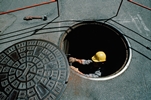
Noise Monitoring Resources
Employers can find assistance in maintaining an effective noise monitoring and hearing loss prevention program from OSHA and NIOSH.
- By Fred Elliott
- Jun 01, 2013
NIOSH's "A Practical Guide to Effective Hearing Conservation Programs in the Workplace," published in 1990, remains an excellent resource for anyone tackling a workplace noise problem. It outlines methods for using sound level meters and dosimeters to measure and document workers' noise exposures, then discusses applicable engineering and administrative controls, audiometric testing, hearing protectors, education and motivation of workers, recordkeeping, and hearing protection program audits.
With the hazard assessment completed, audiometric testing should be performed on employees prior to employment, before they start work in a hearing-hazardous work area, annually as long as the employee is assigned to a noisy job (with a time-weighted average exposure level of 85 dBA or more), when they are reassigned from a hearing-hazardous job, and at the termination of employment. Employees who are not exposed should be given periodic audiograms as part of the company's health care program, according to the guide.
The guide recommends creating a "noise map" of high-noise areas throughout a facility and discusses using engineering surveys to measure the frequency and intensity of noise being emitted by machinery or other sources. Management can use the measurements to decide which engineering controls and preventive methods to utilize.
Two developments that have come to fruition more recently are hearing protectors that offer in-ear dosimetry, monitoring the worker's noise exposure throughout the workday; and an ear plug system that provides a personal attenuation rating for the wearer within seconds of insertion. Both of these provide information about whether the worker is protected or overexposed to noise.
High Hearing Loss Rates for Manufacturing, Utilities
OSHA and NIOSH agree hearing loss is one of the most common occupational illnesses in the United States, with millions of workers regularly exposed to potentially hazardous noise levels while working. Luis Felipe Martinez, a BLS economist, reported in the July 2012 issue of the agency's Monthly Labor Review that hearing loss constituted about 12 percent of all nonfatal occupational illnesses in U.S. private industry in 2010. Encouragingly, the private industry hearing loss rate declined from 3.2 to 2.2 cases per 10,000 full-time workers from 2004 to 2010, according to his report, which said manufacturing and utilities consistently had the highest rates among private-sector industries. Data for his paper came from the Survey of Occupational Injuries and Illnesses (SOII).
Manufacturing's hearing loss rate declined from 16.9 to 12.9 cases per 10,000 full-time workers from 2004 to 2010, while utilities' rate fell from 18.1 to 9.1 cases per 10,000 during the same period. Primary metal manufacturing had the highest hearing loss rate by far in 2010, with a rate of 33.8 cases per 10,000 full-time workers. The same industry also had the highest hearing loss rate in 2004 (40.1), which was the first year BLS hearing loss data were available, Martinez reported.
His paper also says the air transportation industry's hearing loss rate (it more than doubled from 11.4 per 10,000 full-time workers in 2004 to 24.7 in 2010) has been consistently high during the period because of baggage handlers, mechanics, and service technicians exposed to loud aircraft noise; and food manufacturing (its rate declined from 30.3 in 2004 to 19.4 in 2008 but then rose to 22.9 in 2010) and textile mills (their rate has declined from 19.0 in 2004 to 12.7 in 2010) also had rates well above the private-industry average during the period.
His report is available at http://www.bls.gov/opub/mlr/2012/07/art4full.pdf.
Online Resources
NIOSH's online tools (http://www.cdc.gov/niosh/topics/noise/) include the "Practical Guide," a noise meter showing the length of time when exposure to various everyday noises becomes hazardous, and a power tools database that allows users to see tested sound levels of tools made by numerous manufacturers.
Online resources from OSHA include its occupational noise exposure topic page (http://www.osha.gov/SLTC/noisehearingconservation/index.html), which discusses applicable standards and recommended exposure limits, control strategies to reduce noise exposures, and the elements of an effective hearing conservation program.